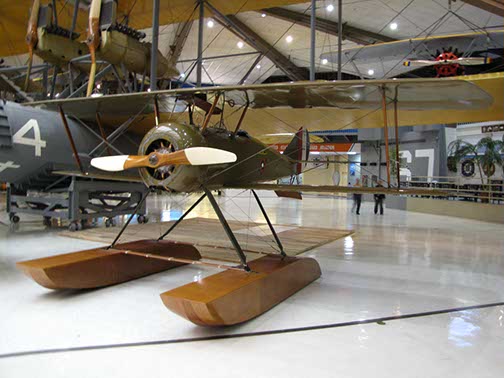NAS Pensacola
Nine photos from the Naval Air Station museum in Pensacola, Florida.
S-4B/C Scout
The museum's example of the Thomas-Morse S-4C was acquired in 1984 from Roy Reagan of Chico, California. It is painted in the markings of Bureau Number A-5858, one of four examples procured by the Navy for fighter pilot training following the end of World War I. In 2000, a pair of twin floats were added in place of conventional landing gear, thus depicting the Thomas-Morse S-5 seaplane (converted from the S-4B) that was used in limited numbers by the Navy as a primary trainer during the Great War.
Notes With war clouds on the horizon for the United States in 1917, the Army Signal Corps realized the need for a trainer to prepare its pilots to fly more advanced fighter aircraft in service over the trenches of Western Europe. The service turned to the Thomas-Morse Aircraft Company's S-4B/C Scout aircraft, known to a generation of pilots as the "Tommy," which featured a unique rotary engine in which the entire engine rotated with the propeller. Though the Army was the recipient of most of the production aircraft, the Navy procured fourteen examples for use as combat trainers. . It was in an S-4C that Lieutenant (junior grade) David Ingalls received training at Naval Air Station (NAS) Dunkirk before joining a Royal Air Force squadron, where he became the Navy's only ace in World War I with six aerial victories.
In addition, Thomas-Morse delivered six S-5s, seaplane versions of the S-4B, to the Navy in 1917 for use as a primary trainer. They flew mainly from Dinner Key near NAS Miami, Florida, their ungainly wooden floats having to be emptied of water by sailors on the ground after each flight. Though the trusty "Tommy" disappeared from military airfields in the years following World War I, it remained in the public eye on the big screen, flying combat sequences in such Hollywood war movies as Hell's Angels and Dawn Patrol.
The museum's aircraft is an S-4C converted to an S-5.
Specifications for S-4C
Manufacturer: Thomas-Morse Aircraft Corporation
Dimensions: Length: 19 ft., 10 in.; Height: 8 ft., 1 in.; Wingspan: 26 ft., 6 in.
Weights: Empty: 963 � lb.; Gross: 1,373 � lb.
Power plant: One 80 horsepower Le Rhone rotary engine
Performance: Maximum Speed: 97 M.P.H.
Armament: One fixed forward-firing .30-in. machine gun
Aircraft in the Museum Collection
S-4C (S-5) (Painted in markings of BuNo A-5858)- On indoor static display
